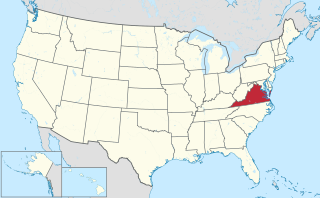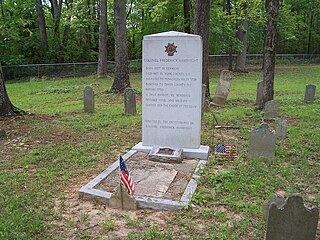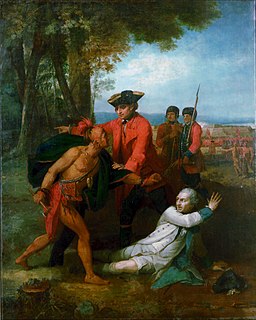The Cherokee Expedition, also known as Christie's Campaign, was a military offensive that occurred during the American Revolutionary War between American forces and Cherokee tribes allied to Great Britain. [1]
An offensive is a military operation that seeks through aggressive projection of armed force to occupy territory, gain an objective or achieve some larger strategic, operational, or tactical goal. Another term for an offensive often used by the media is 'invasion', or the more general 'attack'.

The American Revolutionary War (1775–1783), also known as the American War of Independence, was an 18th-century war between Great Britain and its Thirteen Colonies which declared independence as the United States of America.

The United States of America (USA), commonly known as the United States or America, is a country comprising 50 states, a federal district, five major self-governing territories, and various possessions. At 3.8 million square miles, the United States is the world's third or fourth largest country by total area and is slightly smaller than the entire continent of Europe. With a population of over 327 million people, the U.S. is the third most populous country. The capital is Washington, D.C., and the most populous city is New York City. Most of the country is located contiguously in North America between Canada and Mexico.
The British encouraged and facilitated Cherokee raids in July 1776, into Colonial territories of Virginia, North and South Carolina, and Georgia to wreak havoc among the southern colonies. The state governments responded with a plan for retaliation throughout Cherokee territory. [1]

Virginia, officially the Commonwealth of Virginia, is a state in the Southeastern and Mid-Atlantic regions of the United States located between the Atlantic Coast and the Appalachian Mountains. The geography and climate of the Commonwealth are shaped by the Blue Ridge Mountains and the Chesapeake Bay, which provide habitat for much of its flora and fauna. The capital of the Commonwealth is Richmond; Virginia Beach is the most populous city, and Fairfax County is the most populous political subdivision. The Commonwealth's estimated population as of 2018 is over 8.5 million.

North Carolina is a state located in the southeastern region of the United States. North Carolina is the 28th largest and 9th-most populous of the 50 United States. It is bordered by Virginia to the north, the Atlantic Ocean to the east, Georgia and South Carolina to the south, and Tennessee to the west. Raleigh is the state's capital and Charlotte is its largest city. The Charlotte metropolitan area, with an estimated population of 2,569,213 in 2018, is the most populous metropolitan area in North Carolina, the 23rd-most populous in the United States, and the largest banking center in the nation after New York City. North Carolina's second largest metropolitan area is the Raleigh metropolitan area, with an estimated population of 1,337,331 in 2018, and is home to the largest research park in the United States, Research Triangle Park, in Chapel Hill, Durham, and Raleigh.

South Carolina is a state in the Southeastern United States and the easternmost of the Deep South. It is bordered to the north by North Carolina, to the southeast by the Atlantic Ocean, and to the southwest by Georgia across the Savannah River.
The main force of 1,800 Virginian volunteers under Colonel William Christian marched southwest passed the Northern Cherokee border, while the Georgians attacked north through the Southern border of Cherokee lands. Brigadier General Griffith Rutherford was given command of North Carolina militia and joined up with South Carolina militia under Colonel Andrew Williamson. This attack group aimed at the central heart of Cherokee lands. [1]
William Christian was an Indian fighter, Continental soldier, militiaman and politician from the Colony of Virginia who served in the era of the American Revolution. The Town of Christiansburg, Virginia, is named in his honor. He was a signatory to the Fincastle Resolutions and founder of Fort William. Christian helped to negotiate the Treaty of Long Island—making peace between the Overmountain Men and the majority of the Cherokee tribes in 1777.

Griffith Rutherford was an officer in the American Revolutionary War, a political leader in North Carolina, and an important figure in the early history of the Southwest Territory and the state of Tennessee.
Andrew Williamson was a Scots immigrant who became a trader, planter, and soldier in the South Carolina militia, rising to be commissioned as Brigadier-General in the Continental Army in the American War of Independence. He led numerous campaigns against Loyalists and Cherokee, who in 1776 had launched an attack against frontier settlements across a front from Tennessee to central South Carolina. Williamson was particularly effective in suppressing the Cherokee, killing an unknown number of Cherokees and destroying 31 of their towns. As a result of his Indian campaign, the Cherokee ceded more than a million acres in the Carolinas.
The Cherokee were divided in their plan of action, the elders and majority of the nation seeking peace terms from the Colonials, while a rogue faction, composed mostly of younger men, continued its raids and war with the Colonials. However, these elements fled from any major engagements with the invading force. [1]
The expedition was met with little resistance as it marched into the heart of Cherokee lands in what is now Tennessee. It camped near several Cherokee towns and rebuilt abandoned forts to establish a long term presence. This show of force, although minimal, was enough to discourage further Cherokee raids during the American Revolution. It is likely that terms were made and the expedition returned home in December 1776. [1]

Tennessee is a state located in the southeastern region of the United States. Tennessee is the 36th largest and the 16th most populous of the 50 United States. Tennessee is bordered by eight states, with Kentucky to the north, Virginia to the northeast, North Carolina to the east, Georgia, Alabama, and Mississippi to the south, Arkansas to the west, and Missouri to the northwest. The Appalachian Mountains dominate the eastern part of the state, and the Mississippi River forms the state's western border. Nashville is the state's capital and largest city, with a 2017 population of 667,560 and a 2017 metro population of 1,903,045. Tennessee's second largest city is Memphis, which had a population of 652,236 in 2017.








